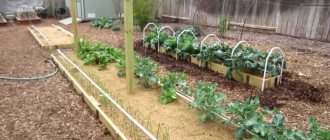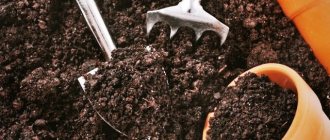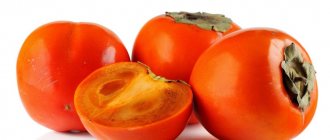» Sharing our experience » Hassle-free vegetable garden for the elderly
0
5329
Article rating
Find out how, with great desire and the right approach, you can turn your garden into a storehouse of vitamins. How to make it a place for pleasant work and relaxation. A hassle-free vegetable garden for the elderly - proper organization of work.
While we are young and energetic, gardening and working in it are not a burden. But time goes by. The areas are large, but there is little use. We don't have time to process everything. Digging, watering, agricultural technology, and fertilizer treatment takes a lot of effort. What to do? Like reaping good harvests and resting, enjoying every day and the works of your hands. A hassle-free garden for the elderly should be worthwhile and bring pleasure.
Why is the garden lazy?
It is in vain that a vegetable garden adapted to reasonable technologies is called lazy. There is an opinion that progress is driven by lazy people. Or maybe they are just rationalists. Why carry out those operations that you can do without? Many people don’t understand how to do without:
- digging;
- hilling;
- daily watering;
- weeding;
- chemical treatments.
But agrotechnical science and biotechnology have already reached a level of knowledge, experience and practice where many operations can be dispensed with.
Gardening a hassle-free work order.
Summer residents often take a creative approach to solving complex problems, so the idea of a vegetable garden in bags can both be of interest and significantly simplify this task. Believe me, such a garden can work better than it sounds!
The scheme is simple. Place plastic bags with soil on the ground, punch drainage holes in the bottom of the bag with a pitchfork and cut the top part, not reaching 6-8 cm to the corners. The bag will serve as an agrofilm for the plants, protecting them from weeds.
After planting the seedlings, the bags should be covered with any mulch - hay, pine needles, bark, etc. That's it, your garden is ready without any hassle! Take care of it as usual - watering, fertilizing, pest control.
If you have a piece of land that you just can’t get around to, this scheme will allow you to quickly improve it.
This can be either an overgrown area, or an area with poor soil or clogged after construction.
This kind of hassle-free vegetable garden works great for busy gardeners. But, if at the initial stage of laying the bags you are not too lazy to remove the grass under them, then your vegetable garden or flower garden in the future will require you to spend less on weeding.
This ingenious idea will allow you to quickly set up a vegetable garden or flower garden in the most inconvenient area in just a day. Could anything be even easier and faster?
Planting potatoes under straw
There are different methods, but we will describe the classic method of growing potatoes under straw. Using this method, we will get a good harvest of vegetables and less labor costs for their cultivation.
Method of planting potatoes under straw in a smart garden:
- We prepare the bed - in winter we plant rye on it and do not mow it. In the spring, it continues to grow, preventing weeds from growing, and at the same time reducing the number of pests in the ridge.
- A couple of weeks before planting potatoes, the rye is cut off and the ridge is dug up, embedding the greens inside the earthen clod.
- Mark the rows - the distance between them should be at least 60 cm.
- We make grooves up to 8 cm deep, into which we place the sprouted potato planting material, maintaining a step of 25-35 cm.
- Cover the spread out tubers with a layer of dry straw of 25 cm.
If the weather is dry when planting tubers, the planted material requires watering.
Using this method you can significantly reduce physical activity, which suits many gardeners. But this method has its drawbacks:
- Straw must be laid in a thick layer so that the tubers do not turn green from the sun's rays.
- Large plots require a lot of straw.
Video about planting potatoes under straw in a smart garden for the lazy:
Why digging is harmful, or smart beds
Of course it's not harmful. The soil needs to be loosened, and some crops (mainly beets and carrots) require deep plowing or digging. But. Why dig where there is no need to dig?
A smart vegetable garden involves high beds. It should be created in such a way that there is convenient access to each plant from all sides. Basically they are made long and narrow. The famous narrow beds are already popular all over the world and vegetable growers have come to the conclusion that they have many advantages:
- there is no danger of soil erosion;
- moisture does not escape beyond the plant growth;
- passages remain free of dirt;
- there is the possibility of creating temporary shelters;
- weeds do not spread;
Portable anti-crisis garden made from plastic bags
It is better to grow many vegetables in bags or plastic bags.
Perhaps the most budget-friendly and less energy-consuming option for creating a vegetable garden anywhere in a summer cottage, even if there is practically none left, is from plastic bags or packages. After all, such a “container” can be placed anywhere, even on a terrace or patio, and almost all vegetables can be grown in it. The most important thing is that your harvest in this kind of house is practically not in danger: neither heat, nor weeds, and most importantly, pests.
On the modern market you can find special bags for growing various types of vegetables and berries.
At the moment, you can purchase special bags for growing vegetables, which are already filled with a nutritious soil mixture; the main thing is to decide in advance what types of plants you will plant, because different vegetables require their own soil composition. The standard dimensions of a vegetable bag are 35 x 95, which allows you to “plant” 2-3 medium-sized plants in it. For different crops, you need to make the right cuts for unique nests or holes; if you place the bag high and cut off the entire upper part, creating a tub, then it is better to plant plants with a shallow root system, for example: peppers, cucumbers, zucchini, tomatoes or eggplants.
Growing vegetables in bags with soil mixture.
To force greens or plant carrots, beets, radishes, radishes or other root vegetables, it is better to place the bag on its side and make a long, wide hole in the center. And if a long and wide hole is cut in the central part of the bag, it can also be used for growing green crops. A very interesting version of African farming, when several types of vegetables are grown at once at different levels of the bag; for this you just need to make neat cuts on the sides of a kind of house.
Stages of filling bags with soil mixture and creating drainage. ogorod.ru
If you decide to fill the bags yourself, then special attention should be paid not only to the quality of the soil, but also to the creation of a special drainage system. To do this, a sufficient layer of stones or expanded clay is poured onto the bottom of the bag, then we cut off the top and bottom from an ordinary plastic bottle, creating a pipe that is installed in the center of the bag and filled with stones. When the soil mixture has been filled and compacted around, the pipe is pulled out and placed again in the center, and filled with stones.
Thus, fill the bag with the prepared substrate to the top. As a result of simple manipulations of laying stone, a kind of drainage “column” is obtained in the center of the bag, which will become a soil moisture regulator. With this method of growing, even in the most arid or humid regions, people will always have vegetables, because proper care helps preserve and increase productivity many times over.
About soil in a smart garden for the lazy
The soil is placed using a special method - layer by layer.
- Bulk material is placed at the bottom. These can be large bars or cut branches of various sizes that will serve as drainage.
- Then lay a layer of newsprint. In this case, you don’t have to purchase special blocks of paper, but put in old newspapers that you’ve read.
- The third layer is thin branches left after pruning bushes and trees.
- A layer of foliage that must be free of fungal spores.
- Compost prepared by yourself or purchased in a store.
- Garden soil.
We must remember that the beds must have fertile soil, so the rules of soil layering should not be neglected. The soil should be loose and fertile. Sometimes, to increase looseness, worms are thrown into it.
7.About watering, mulching
Watering vegetables and herbs is the main part of harvest care.
Therefore, it is necessary to organize watering in such a way that there is no excess or deficiency of moisture. In these lazy beds, watering is done less frequently, but it is necessary. Many gardeners do drip irrigation, for example, from a barrel from which polymer pipes with small holes come. Water is poured into the barrel, and then it evenly waters the vegetable seedlings. Mulching vegetables is necessary - this will protect the soil from drying out. For mulch, use grass that has dried to the state of hay. You can mulch with peat or sawdust.
The soil in the beds should be moderately moist.
We'll look at how they can all be done.
- The standard beds that we are all used to seeing, the edges are made of earth without any fences. Such a bed is not deep into the ground, but does not protrude, you can choose the dimensions yourself, but the main thing is that you can easily get to any area, since many people face the problem that they do not reach the middle of the bed, so often the plants in these areas are sick. The size of the bed depends on its placement; if it is located near a fence, then it is made about 70 centimeters wide and 1.5 m long. The most common standard bed has a width of 1 meter and a length of 1.5 meters; it is also important to take into account the depth, it is 30-50 centimeters. Do not forget to take into account the paths, which should be 40-50 centimeters, this is necessary so that they are easy to walk on, the paths should be 30-50 centimeters below the surface layer of the bed. You can make a square bed, the optimal size is meter by meter. For marking, use pegs with a stretched rope, or you can use special markers.
- Nowadays raised beds have become very popular; they are easy to make, but you have to try. Such beds have many advantages:
- the bed can be cultivated in a variety of places, it can even be asphalt, which is very convenient.
- the beds need to be dug up only twice, in the spring before planting, and in the fall after harvesting
- This bed is easy to assemble and disassemble
- It is much easier to care for plants in such a bed
- planting can begin earlier, this is due to the drainage that is placed in the bed and the soil warms up faster, accordingly the crop ripens earlier
- there are significantly fewer weeds in such beds, since there is not much room for them
- plants are less susceptible to autumn and spring frosts
- raised beds look beautiful and neat, they can come in a variety of sizes and shapes
For example, let's look at how to make a bed 3 meters long, 1.8 meters wide, 40 centimeters high, you can change all these parameters to whatever you want.
To cultivate such a bed we will need:
- boards 5 20, it is advisable to choose wood that is less susceptible to rotting, for example oak
- special impregnation that will protect the boards from rotting
- hacksaw
- miter box
- hammer
- nails
- construction mesh
To begin with, we choose the place where our bed will be located, it needs to be in the sun for at least 5 hours a day, a place where it is not possible to cultivate a regular bed is also perfect, it can be a lawn or a rocky area. All perennial weeds must be removed from the site; if there are any, annual weeds can be left. If you place a bed on the soil, it will be good to dig it up for better moisture permeability. Finally decide on the size.
Features of the technology
Nikolai Kurdyumov is an agricultural scientist with almost 40 years of experience. One of the pioneers of Russian permaculture, who managed to unite and systematize the most valuable domestic and foreign experience in this area. He advocates more natural farming, when the soil should not be “disturbed” by deep and frequent digging, loosening, and weeding, so as not to disturb the natural microflora.
Instead of traditional methods of cultivation, Kurdyumov offers an alternative option - increasing the fertility of the land in certain areas.
Compare the methods: Beds using the Lyadov method
These are “smart” beds. They are more rational than organic “warm” ones, since they do not need to be updated every 2–3 seasons. The soil is radically improved once by adding the missing elements. And then they only support processes that increase fertility.
Related article:
What to make raised beds from: 5 worthy options
Basic Rules:
- If the soil on the site is difficult and does not support the growth of crops, it is easier to make organic “pies”. In southern regions they should be of the trench type to conserve moisture. In the north - high, for quick warming up.
- On clay soils, boxes are placed and powerful drainage is provided. Improved areas rich in organic matter must be separated, otherwise water stagnation and pathogenic putrefactive processes will occur. Another advantage of the boxes: the earth will warm up faster in the spring, promoting an early harvest, while the clay around will remain cold for a long time.
- In areas with a slope, terracing is used - this will retain water during rains, and, in addition, avoid soil sliding. Using raised beds, you do not have to carry out complex earthworks.
- It is not advisable to leave the ground open, either in the planting areas or in the passages between them. You can use agrotextiles, sawdust from fruit or deciduous trees, straw, grass clippings without seeds, and so on. Thus, weathering and drying of the upper soil layers, the growth of weeds, and freezing of roots during a short-term drop in temperature are prevented.
- The long side of the bed is usually oriented from north to south. This is especially important if they have a hilly shape - both sides will have time to warm up equally during the day. For flat landings, orientation is not important.
Find out more about how to make raised beds with your own hands
Soil is the basis of productivity
An organized garden bed should be super fertile. At the same time, from a unit of its area it will be possible to take many times more product than from hectares of an uncultivated field. However, it is impossible to grow a plant without digging, and even on fresh soils that form a tight layer. The soil should be loose and greasy.
It is possible to create fertility with the help of:
- microorganisms;
- earthworms.
Both the first and second need organic matter and moisture.
Healthy!
Organic matter is food for microflora. Microorganisms process organic matter and make mineral components biologically available for absorption by the plant's root system.
The following is used as organic matter in the garden plot:
- vegetable waste;
- kitchen vegetable waste;
- plant weeds before seed formation;
- humus of cattle, horses, goats, rabbits, chickens.
Mobile vegetable garden or flower garden made of plastic or galvanized containers
A mobile garden or flower beds can be created from ordinary plastic boxes or special containers.
The simplest and least labor-intensive option, which can be used not only on an open plot of land, but also on terraces, under a canopy and even a loggia with a balcony, is growing plants in plastic, galvanized or other containers. Naturally, you won’t harvest the harvest on an industrial scale, but you will always find dill, parsley and even tomatoes and cucumbers for the dinner table.
Galvanized mobile beds.
To do this, you will need to buy any containers of different capacities and trays for them (mandatory!), a special substrate and directly the seeds of the plants that you decide to grow. The main thing is to choose the right species and varieties, because for open ground and for growing on loggias they are radically different, but in both cases you should choose compact plants with the same root system, which have a fruiting frequency suitable for your region.
Plastic containers are the best option for organizing a mini-vegetable garden on the balcony.
If you want to have a more aesthetically pleasing appearance for your portable garden, then choose plants with beautiful leaves or unusual fruits; they will not only be a delicious decoration for your table, but also for the entire plot or balcony.
Vegetable garden in Siberia
A peculiarity of Siberian nature is that in summer the temperature rises above 35° Celsius, and in winter it drops to –45°. Therefore, a garden without any hassle in Siberia is not made with wide beds that can be easily covered during the slightest cold snap.
In Siberia there is a man with the last name Zamyatin who recommends a certain rhythm for growing vegetables. So, his plot is not dug up; green manure plus high-quality seeds are used. All this helps to produce consistently high yields. According to his system, a smart Ural vegetable garden should be no wider than 80 cm without any hassle in Siberian conditions.
Arranging a garden bed with your own hands with photos
Kurdyumov experiments a lot, trying out the innovations of his colleagues and testing his own theories. But in general, he adheres to the idea of an organic “pie” with active microflora, as the most universal and effective. On his plot, the agricultural scientist uses high beds, despite the fact that he lives in the Kuban, where it is hot in the summer. For the box, he chose unrounded logs - beautiful, comfortable and durable. However, such a fence cannot be called budgetary, so if you wish, you can make do with edged boards, protecting them with impregnation for difficult conditions.
Related article:
A few golden rules for composting
Classic scheme of a high “pie”:
Earthworm instead of a shovel
Experienced vegetable growers have long noticed that the soils where many earthworms live are light, fluffy, fatty and very fertile.
During their life, worms process organic waste and pass it through their body, producing humus.
Migrating in search of food, they move through the upper layers of the soil, making it loose, water-permeable and breathable.
It should be taken into account that for the worm to function, the soil must always contain organic matter and be constantly moist. After the worm’s “work”, the soil will be structured, and digging it up is not necessary and even harmful.
The earthworm will serve itself. It reproduces well, but not as well as the Californian one. If there are a lot of beds, then vegetable growers buy “seedlings” of the Californian worm and plant them in the beds.
How to burn garbage at your dacha or plot
Burning garden waste in spring or late autumn is a difficult task for many gardeners. Wet residues do not want to flare up. A brick will help in this difficult task. First put it in a dry place so that it dries well. Completely immerse the dry brick in kerosene for three hours. Once it is soaked, wrap it in plastic wrap. Firstly, so that it does not “aromatize” the air, and secondly, this way it will retain its combustible properties longer. When it is necessary to burn the garbage, it is placed inside the prepared pile and set on fire.
It burns long and evenly. To then extinguish the flame, the brick is pulled out of the fire with a stick and covered with a wet, thick rag.
How not to weed the beds
Weeding is a method that serves two purposes:
- Loosening the soil;
- Weed removal.
We have already dealt with loosening; we will leave this procedure to earthworms.
With weed removal, the situation is different. The traditional understanding of this process usually involves mechanical removal of weeds by weeding. As a rule, weeds grow in areas free from crops. However, if you think through sowing and planting wisely, then there will be no free space.
In the first period, when cabbage, for example, is planted in seedlings, there will be space, but the fast-growing crop will unfold the leaf, close the space, and the weeds will not be able to fight.
How to sow carrots without hassle?
Carrots have very small seeds. It is very inconvenient to sow them - sometimes a lot, sometimes a little gets into the furrow of the bed. There is an exit! Take a small medicine bottle. Make a small hole in the lid, slightly larger than a carrot seed. Pour the seeds into a bottle and, closing the lid, sow on the garden bed, like salt. You will get a very economical option.
We, gardeners and gardeners, need good cutting tools: garden knives, shovels, pruning shears, axes, hoes, flat cutters, saws. But, alas, it is very rare now to purchase a high-quality instrument. Hoes quickly become dull and jagged. Shovels bend and break. Not all modern tools can withstand our heavy black soil. But these shortcomings can be easily eliminated by treating them with a weak solution of table salt.
Gardeners have long used hardening and pointing of cutting tools in a solution of table salt. I learned about this trick, this method of sharpening from my father.
The solution is prepared simply: 1 glass of water + 1 tablespoon of salt. Water temperature matters. If the tool is made of hard and brittle (brittle) steel, then it should be slightly warm - + 28-35 ° C. And if the steel is soft, then the water of the salt solution should be even warmer - + 35-40 ° C. Of course, the volume of the solution depends on the size of the tool that you will prepare for sharpening. The tool must be completely immersed in water.
If you are going to harden a new instrument with salt, you must first sharpen it and then put it in a salt solution for half an hour. After this, it can be finally sharpened and directed. Rinse the tool periodically in salt water while sharpening. My father is sure that with such sharpening the tool will not break - the fragility will disappear, the hard steel will become more elastic. Moreover, this tool does not become dull longer and does not wear down as quickly as when sharpened without using salt water.
Black spunbond or film
The following technique will allow in the future to reduce not only weeding, but also watering. Before planting seedlings in the beds, use black non-woven material with a density of 60 g per m² or a film of the same color.
For strawberries, cucumbers, peppers, tomatoes, eggplants, zucchini, cut round holes with a diameter of 10-15 cm in the selected material (the larger the crop, the larger the diameter of the hole). It is most convenient to carry out such work before the material is laid on the ground - cutting out circles when the spunbond or film is already lying on the bed is inconvenient.
After cutting the holes, we lay this synthetic mulch on the bed. To prevent the edges of the materials from rising, for example, I used the following trick. I have an unnecessary narrow rubber hose. Every 30 cm I drove large nails into it (the length of which is 10 cm). Then she placed such a edging along the edge of the selected material, hammered nails directly into the soil, grabbing the edges of the spunbond or film. The bed looks beautiful, and the hose and nails hold the edges of the covering material.
If you don’t have an unnecessary hose, you can cut circles or squares from linoleum so that these blanks are larger than the diameter of the nail heads. Then we drive nails in the same way along the edge of the covering material. By the way, now you can buy dense non-woven material in blue, red, yellow, and green colors. This will allow you to further decorate the beds.
Neighborhood in the garden beds
All plants influence each other. There is a constant struggle for:
- sunlight;
- life-giving moisture;
- nutrients.
Plants also influence with their secretions. Not all plants can safely tolerate phytoncides from onions and garlic, horseradish, celery and even tomatoes.
Not all plants can coexist equally in the sense that they have different needs for soil acidity. However, the science of living together has long identified the best couples.
Healthy!
Plants living in the same territory can not only compete, but also help each other fight pests and pathogens.
Galina Kizima method
Galina Kizima’s methodology is based on the rules of organic gardening, which she gradually came to over 52 years of her “dacha” experience. Like many of us, she devoted all her weekends and vacations to working in the garden; hard work in the garden beds did not allow her to rest at all. Galina Kizima began to look for ways to reduce labor-intensive manipulations without harming the yield.
The principles of agricultural technology and gardening that she developed sometimes completely contradict the conservative and familiar methods of farming. According to Kizima, most manipulations are completely unnecessary and even harm the condition of the soil. By refusing to dig, organizing a moisture conservation system and thereby reducing the frequency and volume of watering, you will be able to relax more at the dacha, devote your free time to family or gardening experiments.
Author's options
There are proprietary options that help gardeners grow large harvests of vegetables.
Kurdyumova
This agronomist practices natural lazy farming and recommends:
- So that the humidity level is always constant.
- The soil must be loose and breathable.
- The soil should not overheat in the summer.
- Soil acidity should be stable.
Video about smart gardening in detail from Kurdyumov:
Galina Kizima
Since growing vegetables begins with seedlings, Galina Kizima grows them in “diapers.” This method allows you to save space on sunny windowsills. To do this, she uses 2 strips of cellophane and toilet paper. He lays a strip of toilet paper on one strip of cellophane, wets it with a spray bottle, sprinkles a little soil on which he places the seeds. The seeds are placed with a ribbon near one edge in increments of 2 cm. After this, they are rolled into a roll, placed in a container with a little water poured in and transferred to a sunny and warm windowsill.
The main principles of her growing method are:
- Do not dig up the beds.
- Do not weed the weeds, but cut them off.
- Mulch the soil around the plants.
Constant growth
One of the rules of a fertile smart bed is constant employment. From early spring to late autumn, the bed should be occupied by crops.
Starting in spring, it can be radishes and spinach. In addition, crops sown in rows will quickly make room for the next one. The radishes go away in a month, and the spinach remains for another 20-30 days, but early tomatoes can already be planted in place of the radishes. By the time the spinach leaves, the tomatoes will have already risen and you can sow basil or dill in place of the spinach.
As soon as the ridge is harvested, do not leave it empty, immediately sow green manure, they are:
- improve the soil;
- destroy pests;
- neutralize pathogens;
- will serve as organic matter in the future.
Important!
By sowing green manure at the beginning of autumn, you will thus take care of the microflora and the worm. The soil under the rhizomes will remain unfrozen longer, and microorganisms will continue to work until deep frosts.
Useful tips
Experienced gardeners with experience advise when caring for smart beds not to forget:
- Apply fertilizers when planting seedlings and subsequently when growing vegetables.
- For the winter, oats, peas or mustard are planted. These plants will enrich the soil for the next harvest and will not allow weeds to sprout.
- The covering material for the beds should be white - this will help to get an early harvest and extend the vegetable harvesting season.
Video about gardening without hassle:
Mulching the area
Having decided to organize a garden without any hassle, no digging, no weeding, no watering, you of course understand that someone must do all these operations for you.
If we have dealt with weeding and loosening, then without moisture, neither the first nor the second will work. Rainwater and melted snow are valuable products and must be carefully collected in any decent reservoirs in order to be used later.
To protect moisture from sweating, soil mulching is used. The technology of using materials has been developed by more than one generation of vegetable growers and has proven itself well.
Mulching has a number of advantages:
- preventing water evaporation;
- protection of the root system from temperature changes (overheating, freezing);
- when using organic mulch, it becomes food for microorganisms;
- mulch does not allow soil to erode and minerals to be washed out;
- prevents soil from getting on the leaf apparatus during rain;
- mulch prevents weeds from growing;
- mulch to some extent protects plants from the attacks of those parasites that go into the ground for the winter;
- improves the aesthetic appearance of beds and gardens;
- prevents low-growing plants (cucumber, strawberry, zucchini) from surface soil contamination.
When choosing mulch, you should consider all its options, and it can be:
- organic;
- not organic.
Organic mulching
The following can be used as organic mulching materials:
- straw;
- hay;
- chopped greens;
- large sawdust;
- shavings and chips;
- needles of pine trees;
- tree bark.
Healthy!
Organic mulch materials are over time processed by microflora and converted into nutrients for plants.
Inorganic mulching
The following can be used as mulching of inorganic nature:
- stone;
- gravel;
- synthetic materials (film).
To mulch flower beds with inorganic mulch in the form of stone, measures should be taken to prevent weed germination. For example, a black film is placed under the stone, which will prevent the germination of weeds, otherwise after a while everything will need to be removed and dug up.
Important!
Such mulch does not rot, although over time it becomes unusable, and when it crumbles (which should not be allowed) it pollutes the beds. In addition, if stone and gravel are appropriate in decorating flower beds, then such material is not appropriate in the garden.
Experienced gardeners have already learned how to skillfully combine organic and inorganic mulch and achieve not only a moisture retention effect, but also an aesthetic one.
Flower garden: natural instead of traditional
In principle, a flower garden or mixborder we are accustomed to cannot be low-maintenance. To make it look beautiful, you need to constantly trim wilted flowers, tie up plants, and monitor their neatness and appearance. Not to mention the weeding!
Article on the topic
A piece of the Land of the Rising Sun. Creating a Japanese-style garden
New Horizons
The appearance of flower beds, which really require almost no maintenance, is associated with the advent of the “new wave” - a landscape design style that has been popular in recent years. The most famous representative of this trend, the Dutch breeder and designer Piet Oudolf , turned the imitation of wild prairies into a trendy garden solution. Such flower beds, of course, may not appeal to lovers of bright roses and peonies, but their beauty is difficult not to appreciate.
The basic principle of the “new wave” flower beds is planting identical plants in large arrays (sometimes with individual accent inclusions of other species). It is not the beauty of each individual flower that is valued, but the overall appearance of the plant - its shape and ability to look good both in summer and winter come to the fore, because perennials in such flower beds are either not pruned at all or pruned at the beginning of the next season. This is their main difference from traditional English mixborders, which have become the basis of flower beds in our gardens.
Adapt to natural conditions
There is no need to act against nature! The result will not be long in coming. For example, if fate has given you a semi-shaded area with a large number of trees, abundant undergrowth and the obligatory coolness of the forest, then there is probably no need to try to arrange a Versailles with a hundred or two roses or a classic English mixborder under the shade of hundred-year-old birch or pine trees. Disappointment from what you have done will come very quickly. And you will increasingly remember the parable of Sisyphus... But don’t be discouraged! You have at your disposal a huge number of shade-loving plants, which, of course, will not make Versailles, but you can get a beautiful, unique and, importantly, low-maintenance garden in all respects, where the kings of such places - rhododendrons - will feel good. Semi-shaded places are the kingdom of hostas, lungworts, buzulniks, ferns, ornamental conifers and many other, dare I say it, gorgeous plants. A. Ganov
The “new wave” flower garden does not have to look neat. The plants fell apart - and okay! After all, you can also fall apart in style, as, for example, burnets or veronicastrum do (unlike tall tulips, delphiniums and gladioli, which cannot do without a garter). And how can such grains as pike, molinia or reed grass look neat? Of course not! But it is precisely the mass of inflorescences that they grow that gives the flower garden airiness, volume, and softness of transitions between brightly flowering perennials.
Photo: AiF/Marina Banulina
Choose carefully
Do you still insist on a traditional mixborder? Pay attention to such a parameter of ornamental perennials as their growth rate. If the curtain grows by more than 5–10 cm per year (such as monarda, physostegia, yarrow, meadowsweet, many autumn-flowering asters, falaris, manna), “keeping the plant in check” will require effort. Plants that need to be divided frequently to maintain their health and decorative appearance (nivberry, delphinium, bearded irises, lilies) or, conversely, those that tend to reproduce by self-seeding (sapling, rudbeckia) also cannot be called easy to care for. By planting them, you are planting future problems with your own hands! A flower garden made up of more compact perennials that rarely require division (hostas, daylilies, peonies, phlox, Siberian and Japanese irises, hellebores, cereals growing in a dense bush) will require much less effort to maintain beauty. Surprisingly, even a ceremonial rose garden often needs less care than a flower garden of the most common unpretentious perennials. Elena Kozhina, experienced gardener
Photo: AiF/Victor Tropchenko
Article on the topic
We are building... ruins! Ancient ruins will draw attention to your garden Prune plants in autumn? What for? Miscanthus, reed grass, monarda, echinacea, veronicastrum, mullein will last well all winter, creating the volume that the winter garden so lacks. After all, an ordinary mixborder with stems cut in the fall looks like a boring plane until spring. Is it a “new wave” flower garden? It is especially beautiful after the first snowfall, when the snow has only dusted but not yet broken the dried grass stems.
Cleaning and pruning are carried out in the spring, when the snow has melted, but perennials and grasses have not yet begun to grow. In the climate of central Russia, this begins in mid-April. When cutting, you usually have to use a sickle or pruning shears, since the stems of many tall perennials are too stiff and simply raking them will not work. Most varietal plants do not self-sow (they are specially selected for this feature), so you can safely put everything cut into a garden shredder and get an excellent mulching material. Mulch helps reduce water evaporation, reduce the number of germinating weed seeds and, rotting, turns into excellent loose soil over time. Unlike conifer bark, crushed perennial stems do not acidify the soil.
Photo: AiF/ Brasova
What to give up?
If the idea of low-maintenance gardening is at the forefront, then you will have to “give up” some plants. First of all, these are young perennials (there is such a slightly absurd-sounding concept!). Such plants include many varietal echinaceas (sadly), some primroses, columbine plants, snakeheads... The fact that these plants are short-lived does not mean that they will become “Persona non Grata” in your garden. You just need to remember that they will require a little more attention than “true perennials”, sometimes capable of living in one place for a hundred years: herbaceous peonies, hostas, many ferns, etc. A. Ganov
Article on the topic
Stylish beds. How to arrange a vegetable garden on your property without compromising the design. Can such a flower garden be called completely maintenance-free? Certainly not. But it requires much less attention than the usual flower border. In addition to spring pruning, it will have to be watered in the driest months, occasionally fertilized and weeded once or twice a season, since, despite the mulch, weed seeds will still germinate.











